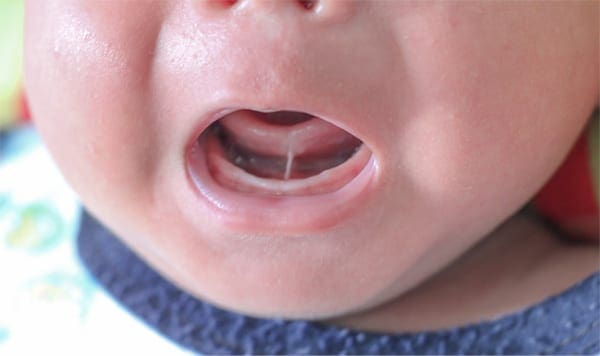
My baby is having trouble latching, what is a frenectomy?
If we say someone is “tongue tied”, we refer to someone that is too shy to speak. Did you know this phrase originated from describing people whose tongues lacked mobility due to a short frenum? If your baby is tongue tied or has a short lip attachment, you can speak up for them and get them help.
What is a frenectomy?
A frenum is a string-like section of tissue that attaches the tissue of your tongue and lips to your mouth. Your dentist will do a knee to knee exam where you hold the baby together to see into their mouth. If the doctor finds that the frenum restricts movement of the tongue or lip, it may require a frenectomy. A frenectomy is the procedure to remove this tissue to free up movement of the lip or tongue.
What happens if it is left untreated?
A tight frenum can make breastfeeding painful and frustrating, or bottle feeding difficult. The American Academy of Pediatric Dentistry states “The most common symptoms babies and mothers experience from tongue and lip-tie are poor or shallow latch on the breast or bottle, slow or poor weight gain, reflux and irritability from swallowing excessive air, prolonged feeding time, milk leaking from the mouth from a poor seal, clicking or smacking noises when nursing/ feeding, and painful nursing.”
In addition, there is ongoing research on an untreated tongue tie affecting airway and sleep apnea issues, jaw development, increased risk of dental cavities, posture and TMJ problems, and speech development issues. These should be discussed and treatment decided on a case by case basis with your child’s medical and dental team. Currently, the main indication for an infant frenectomy is issues with feeding. Also, some adults benefit from frenectomies to prevent gum recession and to help complete their orthodontic treatment.
What is the treatment? Does it hurt?
The short answer is no! It is a very simple, brief procedure. Your baby will not need to be sedated. There will be three people helping the baby be safe and still for this under five minute procedure, and of course mom and dad can be right there as well. The dentist will hold the tongue or upper lip up, and make a small cut to release the tie. This is done in one motion (and our doctors are very gentle, sneaky and quick!). This does not require anesthetic, as the injection would actually be more uncomfortable than the small snip. Babies are generally a little surprised, but calm down quickly. Once the procedure is done, we recommend breast or bottle feeding to soothe and provide a private space to do so. We usually schedule these visits at the beginning or the very end of the day.
We recommend infant Tylenol be taken before the procedure, and continued as needed at the recommended dose as the mouth heals.The doctor and assistants will go over post-op instructions and exercises with you at the appointment and are happy to answer any questions. They will also discuss the minimal risks involved with this procedure, for example, post surgical infection at the site, swelling/bruising, tenderness, or reattachment of the frenum. Healing requires simple daily movements to keep that muscle and tissue from reattaching. Total healing occurs quickly, in 1-2 weeks.
RDH magazine shares these results from frenectomies “A study by Sethi, et al. (2013), found that 77% of mothers who had babies with ankyloglossia [tongue tie] reported improvement with breast-feeding following frenectomy. Other causes for difficulty in breast-feeding may have occurred as well, but 40 out of 52 mothers saw an improvement in these problems within two weeks of the procedure.” This is a practical, simple solution to many latching issues! We are happy to meet you and your baby for a consultation and see if this procedure will help. Feel free to contact us with any questions you may have.
